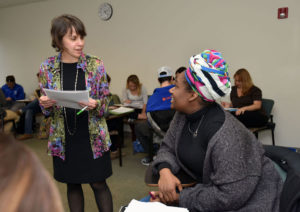On this page
- Competency and Capacity Development for Faculty and Staff
- Faculty and Staff Recruitment
- Faculty and Staff Retention
Competency and Capacity Development for Faculty and Staff
Priority
Expectations of diversity and inclusion skills (competencies) that faculty and staff must demonstrate in their work need to be clearly articulated and implemented into training and education for professional and skill development. Upon the articulation of these expectations, we must provide opportunities for skill development (capacity). Accountability structures must be created and placed in annual evaluations.

Goal
Develop a campus culture that has an expectation of diversity and inclusion promotion as an essential capacity and that incorporates cultural competency and capacity as a measure in the assessment of the performance of staff and faculty and the success of institutional initiatives, programs and services.
Recommended Strategies
Faculty
- Develop a diversity and inclusion component into the new faculty orientation process to ensure that all new faculty are aware of opportunities for involvement in enhancing the diversity and inclusivity of our campus, as well as clear guidelines for reporting incidents of bias.
- Expand annual workshops and trainings offered to tenure-track and non-tenure track, ongoing and visiting faculty on topics of diversity and inclusion, mentorship, and implicit bias with the goal of reaching all faculties. These efforts should be made regularly available, at least twice a year.
- Targeted workshops and training for departmental chairs and mentors on how to identify and discuss diversity problems within course evaluations or in a faculty member’s annual review.
- Begin conversations with faculty about how to develop competency requirements and assessment metrics for faculty members, particularly for post-tenure faculty members who are not reviewed annually. Consider the inclusion of diversity as a core competency in the annual performance evaluation for pre-tenure faculty under the category of college service as a requirement for promotion.
- Review current process for teaching evaluation and include standardized content to evaluate a faculty member’s treatment of diversity in the classroom.
Staff
- Require that all Senior Managers and Vice Presidents include a diversity component in their Annual Reports and report out on their departmental or divisional efforts to advance and support diversity and inclusion within their respective areas and across campus. Publish divisional reports annually.
- Establish diversity as a core competency in the annual performance evaluation for staff and assess staff on their work and efforts to support diversity and inclusion within their respective role.
- Develop a diversity and inclusion component into the staff orientation process.
- Expand annual workshops and trainings offered to staff on topics of diversity and inclusion.
Progress
- Secured the competitive $1 million grant from the Howard Hughes Medical Institute (HHMI) to support inclusive excellence in STEM
- Launched the Center for Collaborative Teaching and Learning, supported by a $400,000 donation
- Hosted Bias and Harassment Prevention training, lead by Human Resources
- Implicit Bias Training is now a requirement for all faculty search committee members
Faculty and Staff Recruitment
 Priority
Priority
Recruiting and retaining talented, dedicated and diverse staff and faculty continues to be a goal for the college. Numbers have remained stagnant over the last few years, but setting strategic goals and priorities as laid out below will help make improvements in this area.
Goal
Develop and institute processes, policies and strategies that account for the different processes for staff and faculty recruitment while ensuring an expectation and accountability for diversity efforts in staff and faculty recruitment.
Recommended Strategies
Faculty
- To ensure consistency and accountability, establish a formal role of FAAO as part of a current Associate Provost role or another administrative role within the Office of the Provost.
- Establish processes that ensure that diversity is a focus throughout all staff and faculty searches. Require proactive collaboration with HR for staff and FAAO for faculty searches to ensure that diversity efforts are a part of every search and that efforts are monitored through data. Require hiring managers and search chairs to develop a diversity search strategy for searches. Require VP and Provost review of diversity efforts undertaken in a search. Require VP approval for all staff hires and Provost approval for all faculty hires.
- Charge each Associate Provost with responsibility for developing partnerships with programs that graduate PhD’s from underrepresented groups to develop a pipeline for potential faculty candidates.
- Establish a requirement that all faculty search committees participate in Implicit Bias training.
- Ensure that PeopleAdmin system is used for tracking and assessment of diversity of candidate pools. Develop standard reports to review and assess success of diversity recruitment efforts.
Staff
- Identify a “Staff Diversity Liaison” within each division whose role it will be to collaborate with HR, hiring managers and Division Officers on the diversity efforts for searches within their respective division. Establish expectation and accountability for improved diversity recruitment at the VP level.
- Establish processes that ensure that diversity is a focus throughout staff searches. Require proactive collaboration with HR for staff searches to ensure that diversity efforts are a part of every search and that efforts are monitored through data. Require hiring managers to develop a diversity search strategy for searches. Require VP review of diversity efforts undertaken in a search. Require VP approval for all staff hires.
- Continue to require that department managers participate in Implicit Bias training on a regular basis.
- Establish diversity and inclusion as a required skill for all staff positions and clearly articulate this requirement in all job description and interviews.
- Ensure that PeopleAdmin system is used for tracking and assessment of diversity of candidate pools. Develop standard reports to review and assess success of diversity recruitment efforts.
Progress
- The Faculty Affirmative Action Officer role has been formalized and built into the new Associate Provost for Diversity and Faculty Development
- Implicit Bias Training is now a requirement for all faculty search committee members
Faculty and Staff Retention
Priority
Reasons why staff and faculty leave the institution need to be determined and attempts to mitigate these reasons put into place. Strategies should be developed to retain faculty and staff.
Goal
Develop and institute processes, policies and strategies that support and advance efforts to develop and retain staff and faculty from underrepresented groups.
Recommended Strategies:
Faculty
- Develop a formal exit interview process for all tenure-track and tenured faculty separations. Track and monitor exit interview data to identify challenges or obstacles to success for faculty from underrepresented groups.
- Conduct regular “retention” interviews of tenure-track faculty from underrepresented groups to assess campus climate and faculty satisfaction.
Staff
- Expand the current exit interview survey for staff to include questions that solicit feedback on the experience of staff from underrepresented groups and that identify challenges or obstacles to success and/or employee engagement.
- Conduct regular “retention” interviews of staff from underrepresented groups to assess campus climate and staff satisfaction.
Progress
- Launched the Center for Collaborative Teaching and Learning, supported by a $400,000 donation
- Secured the competitive $1 million grant from the Howard Hughes Medical Institute (HHMI) to support inclusive excellence in STEM

 Priority
Priority